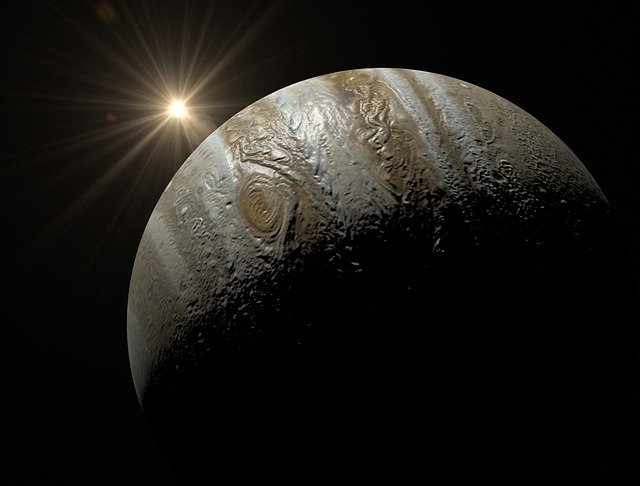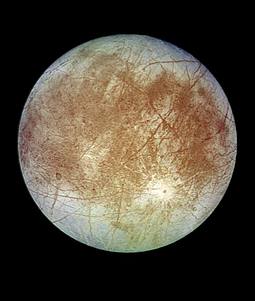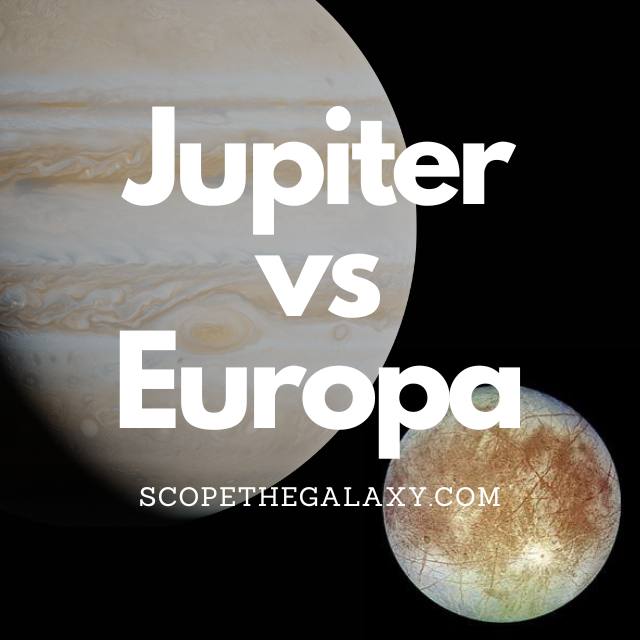*This post may contain affiliate links. This means we may make a commission if you purchase an item using one of our links*
The main differences between Jupiter and Europa is that Jupiter is a gas giant, that is also the largest planet in our solar system that has 79 other moons orbiting it whilst Europa is Jupiter’s 4th largest moon, it is a terrestrial based entity that has water ice on it surface and also orbits Jupiter in an elliptical manner whilst tidally locked to it.
There are various other differences between the two so continue reading for a more detailed look at each celestial body below along with some of their similarities and how they differ.
What Is The Planet Jupiter?
Table of Contents

Jupiter is the 5th farthest planet from the Sun and the largest planet within our local solar system. The planets most recognizable trait is the giant red spot visible on its atmosphere along with the brown horizontal bands flowing across its atmosphere.
As a result of its composition and size, Jupiter falls under the classification of a gas giant.
This is because its composition mostly consists of the elements hydrogen and helium. The split is roughly 71% hydrogen, 27% helium, with the remainder of the elements split throughout the left over 2%.
As the biggest planet in our solar system, Jupiter is 139,820 km or 1,300 Earths in diameter, it has a mass of around 0.001 solar masses, the temperature when inside the clouds are roughly -145 degrees Celsius whilst the core is far hotter, equating in the region of 24,000 degrees Celsius.
Due to its extreme circumstances, gaseous composition and distance from the Sun, the planet is not theoretically capable to support life, from its subzero temperature to the extremely fast 640 km/h winds, and its gravity which may be unsustainable for our bones, roughly 2.4 times greater than Earth’s.
Although the conditions on Jupiter aren’t suitable for us, some of its 79 moons like Europa for example could support life.
This brown giant has a relatively fast rotation around its axis where 1 rotation typically takes 10 hours to make whilst its orbit around the Sun is far longer taking in the region of 12 years for 1 full cycle.
Another feature of Jupiter that is renowned by astronomers is the strength of its magnetic field. In comparison to the other planets in our solar system it is even stronger than our Sun, where it’s over magnetosphere is roughly 20,000 times the strength of Earth.
What this means is that Jupiter’s magnetosphere is able to avert solar winds that are 3 million kilometers away from it.
What Is The Moon Europa?

Europa is the smallest of the Galilean moons, first discovered on 8th January 1610. The surface of this icy world is frozen, but scientists believe a watery ocean could lie beneath the surface. And in 2012, researchers found a possible water plume in the Southern polar region of Europa.
This research is yet to be confirmed; still, it gives us reasonable grounds to hypothesize that water could exist on this icy moon.
Estimates place Europa at around 4.5 billion years old (the same age as its planet, Jupiter), and its average distance from the Sun is approximately 780 million km.
It has a diameter of 3,121.6km, which makes it larger than Pluto but smaller than the Earth’s moon, and the maximum temperature is a chilly -160 degrees Celsius. In regards to mass, it measures in around 4.8 × 10^22 kg.
Europa takes three-and-a-half days to orbit its planet at an average distance of 670,900km, and it is tidally locked, meaning the same side of the moon always faces Jupiter.
Among the fascinating features of this ice moon is its incredibly reflective nature. The icy crust of this body provides a light reflectivity of 0.64 – the highest of any moon in the solar system.
Data from the Galileo spacecraft suggests that Europa is composed of an iron core, rocky mantle, and silicate rock (a similar composition to Earth).
The moon’s surface is covered in cracks, which many theorize could result from tidal currents beneath the surface. It is this potential of water – and of life – that keeps astronomers so interested in this moon.
Europa might be small, but astronomers estimate it holds two to three times more water than the Earth. In addition, this moon possesses the essential elements for life, such as carbon, oxygen, hydrogen, and nitrogen.
There may be no solar energy on this moon, but hydrothermal vents could provide energy, and tidal heating from Jupiter could provide a heat source and keep the moon stable enough for life to form. In addition, the liquid ocean is well protected from radiation from thick, icy surfaces.
Similarities Between Jupiter and Europa
Jupiter and Europa don’t have too many similarities but some elements are still shared, which in this case includes the below:
- Both are a spherical shape.
- Both have a hotter core.
- Both also orbit another entity.
- Neither have tectonic plates.
- Both take 12 years to orbit the Sun.
Differences Between Jupiter And Europa
In regards to the differences between the two, they include the following:
- Jupiter is a gas giant planet whilst Europa is a natural satellite that orbits Jupiter.
- Jupiter has 79 moons orbiting it whilst Europa has no other satellites orbiting it.
- Europa is composed mostly of water ice and rock whilst Jupiter is a gas giant composed mostly of hydrogen and helium.
- Jupiter is far bigger with a diameter of 139,820km whilst Europa’s diameter is 3121.6km.
- Europa has no rings whilst Jupiter has 4.
- A day on Jupiter take 10 hours whilst a Europa day is 3.5 days.
- Europa’s density is 3.01 g/cm³ whereas Jupiter has a density of 1.33 g/cm³.
- Jupiter’s gravitational strength is 24.79 m/s² whilst Europa’s is 1.315 m/s.
- Jupiter has the largest and most powerful magnetosphere in the solar system whilst Europa has no magnetosphere to speak of.
- Jupiter’s axial tilt is 3.13 degrees whereas Europa’s is lesser at 0.1 degrees.
- Europa is tidally locked to Jupiter which itself isn’t tidally locked to anything.
- Jupiter orbits the Sun in a circular pattern as opposed to Europa that orbits Jupiter in an elliptical pattern.
- Jupiter has a mass of 1.898 × 10^27 kg compared to Europa’s that is 4.8 × 10^22 kg.
- Jupiter’s orbit around the Sun is almost circular whilst Europa orbits Jupiter in am obvious elliptical pattern.
Summary
Even though Europa and Jupiter are located very close to one another (as Europa does orbit Jupiter), there really isn’t too much that these two have in common.
Whether it be in regards to their size, mass, density the strength of their magnetosphere and more, Jupiter and Europa are clearly designed to function very uniquely from one another.

